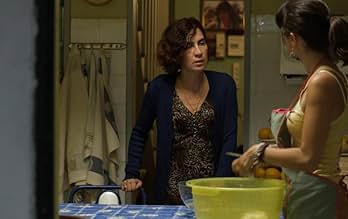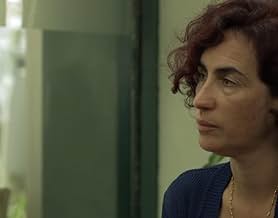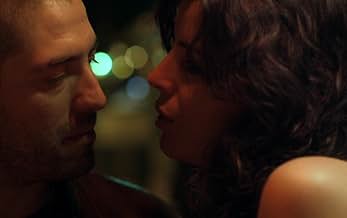IMDb RATING
7.3/10
2.1K
YOUR RATING
A regular family living in the outskirts of Lisbon sees the serenity of their lives shaken beyond any remedy within a week.A regular family living in the outskirts of Lisbon sees the serenity of their lives shaken beyond any remedy within a week.A regular family living in the outskirts of Lisbon sees the serenity of their lives shaken beyond any remedy within a week.
- Awards
- 21 wins & 9 nominations
Maria João Vaz
- Algarvio
- (as João Vaz)
- Director
- Writer
- All cast & crew
- Production, box office & more at IMDbPro
Storyline
Did you know
- TriviaPortugal's official submission to the Best Foreign Language Film category of the 85th Academy Awards 2013.
Featured review
Going way over the safety of ninety minutes into the territory that is so often too long, at two hours twenty, Blood of my Blood easily justifies this extended playtime through captivating characters, patience, flawless pacing and a firm central premise that is supported with every tool at the filmmaker's disposal. The film utilizes a feature that often assists the longer films, it makes use of a large cast of characters. Though having some major focus, the film manages to drift around the experiences of several generations of one family, living in a low-income area of urban Portugal. The linchpin is the mother Marcia, who is a definite mother of the year candidate, just as Rita Blanco, who plays her superbly, is easily my performance of the festival so far. The other major characters are her twenty something kids Cláudia (Cleia Almeida) and Joca (Rafael Morais), then there's their partners, and Marcia's sister Ivete, who pretty much all live in the same tiny flat. Amongst the many links between characters, there are two central plot strands that stand out. Primarily, there's Cláudia's affair with her college professor and her mother's objections to it. Yet almost as prominent is Joca's hazardous attempts to rip off his drug dealer boss. These are quite conventional plot setups and therefore in no way do justice to the originality with which the film is put together. The heart of the film, its soul and its central premise is its interconnectedness. In terms of the plot, the various strands and characters – in addition to this one family at its core – often refer to one another, cross each other's paths, or their relations to one another gradually become apparent. In grander thematic terms, this interconnectedness is related to the strength of community in such a dense, low-income area. This results in the familial bonds being watertight, and people seem sure of themselves in ways that characters rarely do in the countless 'middle-class guilt, straight white men with lost souls' narratives that populate a great deal of art-house hits. In this respect, Blood of my Blood avoids depicting this community with a 'pity the poor' agenda, and although it doesn't suggest it is an aspirational way of life, it certainly doesn't give the usual 'unbreakable cycle destined to fail' scenario.
I suggest that should it be read as such, it will be by people that haven't themselves lived in, or experienced such a low-income community, where there are only two degrees of separation between anyone you might run into in a limited social circle; people that don't know how, within such a microcosm, people are looked out for. The plot very clearly postulates how family are there for one another in the way that Marcia stands by her daughter with such passion and strength, and how the more complex relationship between Jaco and his aunt Ivete plays out. But further to this, we see many subtle narrative elements that illustrate people looking out for each other, or having more than their own narrow motivations at the front of their mind. This is contrasted with the middle class teacher who Cláudia is having an affair with, who seems trapped in an arrested development, not clearly thinking about the wellbeing of Cláudia or for his own wife and family, or even for himself, acting in a familiar self-defeating manner (a human trait depicted so vividly by another outstanding film at the festival Post Tenebras Lux). The film lays the foundations for all these developments at pretty much the outset. After the first scene illustrates the neighborhood they populate and the hazards it contains, the following scene is an iconic dinner table scene. Always a narrative tool to develop and showcase family dynamics, this scene introduces all characters subtly, setting them up with a view to filling in the details as the film progresses. Rather than spoon-feeding exposition on individual characters at this point, the film is much more concerned with establishing the importance of the connections.
Further to these narrative examples, all formal elements worked in harmony with this premise, rather than being used for their own sake with style rather than substance. The interconnected theme was supported by inventive techniques such as the camera coming away from a conversation to allow another conversation to seep into the frame, with both then going on simultaneously; or by the fact that there is very rarely just one thing going on in frame; or that in the absence of any non-deigetic sound or music, the radio or TV can be heard or seen in the background pretty much throughout. This persistently emphasises the hectic nature of this life and that none of these people are islands. Additionally, the long takes – along with being a convention of non/anti-Hollywood cinema – act to gel the different characters together as part of the same organic space. Therefore form and content both support each other to show these characters to be connected as part of this not only literally, but socio-culturally and meta-physically densely populated space.
In spite of the melodramatic plot strands mentioned above, the film is more than anything an earnest and insightful snapshot of life. Over the final credits we hear some Portuguese hip-hop, featuring a chorus comprising of the sample of an American track repeating the words 'street life'. This sums the film up as far as I am concerned; it is simply a slice of street life. I don't think it was relentlessly grim, but nor do I think it was overly celebrated or glamorized; it was simply a slice of life.
I suggest that should it be read as such, it will be by people that haven't themselves lived in, or experienced such a low-income community, where there are only two degrees of separation between anyone you might run into in a limited social circle; people that don't know how, within such a microcosm, people are looked out for. The plot very clearly postulates how family are there for one another in the way that Marcia stands by her daughter with such passion and strength, and how the more complex relationship between Jaco and his aunt Ivete plays out. But further to this, we see many subtle narrative elements that illustrate people looking out for each other, or having more than their own narrow motivations at the front of their mind. This is contrasted with the middle class teacher who Cláudia is having an affair with, who seems trapped in an arrested development, not clearly thinking about the wellbeing of Cláudia or for his own wife and family, or even for himself, acting in a familiar self-defeating manner (a human trait depicted so vividly by another outstanding film at the festival Post Tenebras Lux). The film lays the foundations for all these developments at pretty much the outset. After the first scene illustrates the neighborhood they populate and the hazards it contains, the following scene is an iconic dinner table scene. Always a narrative tool to develop and showcase family dynamics, this scene introduces all characters subtly, setting them up with a view to filling in the details as the film progresses. Rather than spoon-feeding exposition on individual characters at this point, the film is much more concerned with establishing the importance of the connections.
Further to these narrative examples, all formal elements worked in harmony with this premise, rather than being used for their own sake with style rather than substance. The interconnected theme was supported by inventive techniques such as the camera coming away from a conversation to allow another conversation to seep into the frame, with both then going on simultaneously; or by the fact that there is very rarely just one thing going on in frame; or that in the absence of any non-deigetic sound or music, the radio or TV can be heard or seen in the background pretty much throughout. This persistently emphasises the hectic nature of this life and that none of these people are islands. Additionally, the long takes – along with being a convention of non/anti-Hollywood cinema – act to gel the different characters together as part of the same organic space. Therefore form and content both support each other to show these characters to be connected as part of this not only literally, but socio-culturally and meta-physically densely populated space.
In spite of the melodramatic plot strands mentioned above, the film is more than anything an earnest and insightful snapshot of life. Over the final credits we hear some Portuguese hip-hop, featuring a chorus comprising of the sample of an American track repeating the words 'street life'. This sums the film up as far as I am concerned; it is simply a slice of street life. I don't think it was relentlessly grim, but nor do I think it was overly celebrated or glamorized; it was simply a slice of life.
- aamandastone
- Mar 15, 2012
- Permalink
- How long is Blood of My Blood?Powered by Alexa
Details
- Release date
- Country of origin
- Language
- Also known as
- Blood of My Blood
- Filming locations
- Production company
- See more company credits at IMDbPro
- Runtime2 hours 11 minutes
- Color
- Sound mix
- Aspect ratio
- 1.85 : 1
Contribute to this page
Suggest an edit or add missing content
































